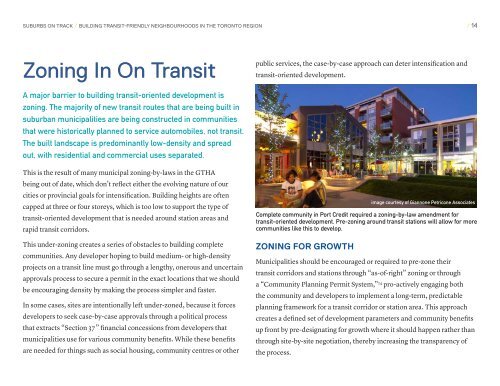SUBURBS ON TRACK
9oHn303Zgxi
9oHn303Zgxi
Create successful ePaper yourself
Turn your PDF publications into a flip-book with our unique Google optimized e-Paper software.
<strong>SUBURBS</strong> <strong>ON</strong> <strong>TRACK</strong> / BUILDING TRANSIT-FRIENDLY NEIGHBOURHOODS IN THE TOR<strong>ON</strong>TO REGI<strong>ON</strong> / 14<br />
Zoning In On Transit<br />
public services, the case-by-case approach can deter intensification and<br />
transit-oriented development.<br />
A major barrier to building transit-oriented development is<br />
zoning. The majority of new transit routes that are being built in<br />
suburban municipalities are being constructed in communities<br />
that were historically planned to service automobiles, not transit.<br />
The built landscape is predominantly low-density and spread<br />
out, with residential and commercial uses separated.<br />
This is the result of many municipal zoning-by-laws in the GTHA<br />
being out of date, which don’t reflect either the evolving nature of our<br />
cities or provincial goals for intensification. Building heights are often<br />
capped at three or four storeys, which is too low to support the type of<br />
transit-oriented development that is needed around station areas and<br />
rapid transit corridors.<br />
This under-zoning creates a series of obstacles to building complete<br />
communities. Any developer hoping to build medium- or high-density<br />
projects on a transit line must go through a lengthy, onerous and uncertain<br />
approvals process to secure a permit in the exact locations that we should<br />
be encouraging density by making the process simpler and faster.<br />
In some cases, sites are intentionally left under-zoned, because it forces<br />
developers to seek case-by-case approvals through a political process<br />
that extracts “Section 37” financial concessions from developers that<br />
municipalities use for various community benefits. While these benefits<br />
are needed for things such as social housing, community centres or other<br />
Z<strong>ON</strong>ING FOR GROWTH<br />
image courtesy of Giannone Petricone Associates<br />
Complete community in Port Credit required a zoning-by-law amendment for<br />
transit-oriented development. Pre-zoning around transit stations will allow for more<br />
communities like this to develop.<br />
Municipalities should be encouraged or required to pre-zone their<br />
transit corridors and stations through “as-of-right” zoning or through<br />
a “Community Planning Permit System,” 24 pro-actively engaging both<br />
the community and developers to implement a long-term, predictable<br />
planning framework for a transit corridor or station area. This approach<br />
creates a defined set of development parameters and community benefits<br />
up front by pre-designating for growth where it should happen rather than<br />
through site-by-site negotiation, thereby increasing the transparency of<br />
the process.


